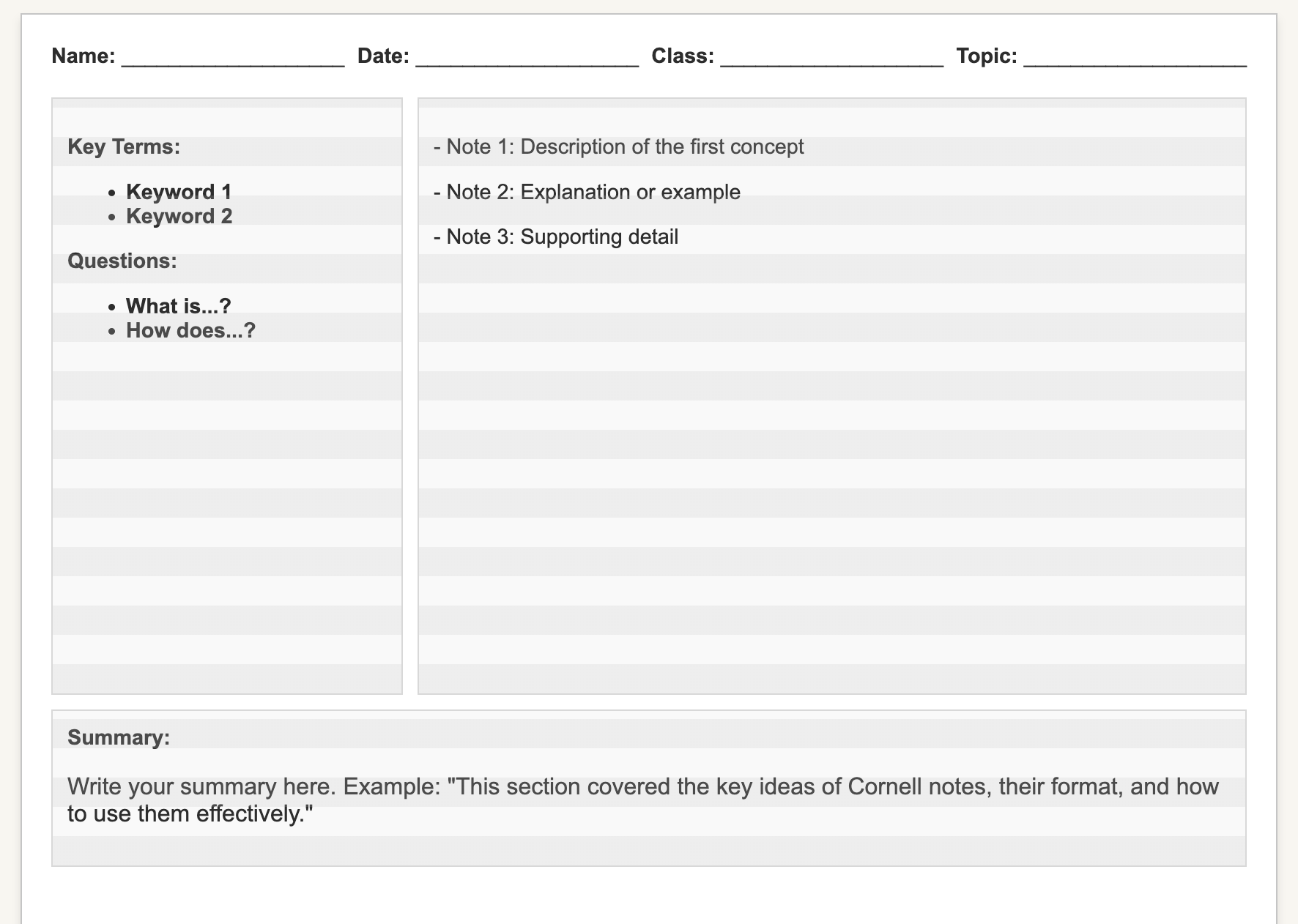Master the Cornell Note-Taking Method: Boost Your Learning, Memory, and Exam Scores
Learn how this proven note-taking system can revolutionize your study habits, improve information retention, and help you ace your exams.

Why Most Students Take Terrible Notes (And How It's Hurting Your Grades)
Let me paint a familiar scene: It's lecture day. You arrive, coffee in hand, determined to capture every valuable insight your professor shares. Two hours later, you leave with pages of hastily scribbled notes—some incomplete sentences, random facts, and a few doodles in the margins.
Sound familiar?
I've been there too. For years, my note-taking strategy was basically "write down as much as possible and hope for the best." When exam time rolled around, I'd stare at these chaotic pages wondering how they were supposed to help me study.
Here's the truth: most of us were never actually taught how to take effective notes. We just picked up habits along the way, many of which don't serve our learning goals.
That's where the Cornell Note-Taking Method comes in—a systematic approach to note-taking that transformed my academic experience, and has helped countless students turn information overload into organized, actionable knowledge.
What Is the Cornell Note-Taking Method?
The Cornell Note-Taking Method was developed in the 1950s by Walter Pauk, an education professor at Cornell University. He created this system to help his students organize, synthesize, and absorb information more effectively.
Unlike standard note-taking, the Cornell Method provides a structured framework that not only captures information but also builds in time for reflection, questioning, and summarizing—all critical components of deep learning.
The Cornell Note-Taking System: A Visual Breakdown
The Cornell Method divides your note page into three distinct sections:
- Notes Column (Right) - The largest section where you record lecture notes, reading points, and class material
- Cue Column (Left) - A narrower column for questions, keywords, and memory triggers
- Summary Area (Bottom) - A space at the bottom of the page to synthesize the main ideas

This simple structure is what makes the Cornell Method so powerful—it's designed to work with how your brain actually processes and retains information.
How to Use the Cornell Note-Taking Method: A Step-by-Step Guide
Let's break down exactly how to implement this method for your next class, lecture, or study session.
Step 1: Prepare Your Paper
Before your lecture or reading session:
- Draw a vertical line about 2.5 inches from the left side of your paper
- Draw a horizontal line about 2 inches from the bottom of your page
- Label the sections: "Notes," "Cues," and "Summary"
Don't have time to draw lines? You can find printable Cornell templates online, or use a notebook specifically designed with this format.
Step 2: Take Notes During Your Lecture or Reading (Notes Column)
In the largest section of your paper:
- Record important facts, ideas, and concepts
- Use abbreviations and symbols to capture information quickly
- Leave space between ideas for later additions
- Focus on capturing key points rather than writing everything verbatim
- Use indentation or bullet points to show relationships between ideas
For example, in a psychology lecture on memory, your notes might include:
- Definition of working memory
- Capacity limitations (7±2 items)
- Techniques for memory enhancement
- Connection to study habits
Have you ever noticed that writing less but more thoughtfully actually helps you remember more? Try focusing on quality over quantity in your notes.
Step 3: Create Questions and Cues (Cue Column)
This is where the magic happens. As soon as possible after the lecture (ideally within 24 hours):
- Review your notes while the information is still fresh
- In the left column, write questions that your notes answer
- Add keywords, key concepts, or memory triggers
- Create connections to previous material
For our psychology lecture example, your cue column might include:
- What is working memory?
- Why is capacity limited?
- How can I apply memory techniques to my study routine?
This process of formulating questions forces you to engage with the material in a deeper way, moving from passive recording to active thinking.
Step 4: Summarize the Main Ideas (Summary Area)
At the bottom of your page:
- Write a brief summary (2-3 sentences) capturing the most important points
- Focus on the big picture—what are the key takeaways?
- Use your own words rather than copying directly from your notes
For our psychology example, a summary might be: "Working memory temporarily holds and processes information with limited capacity. Understanding these limitations helps explain why certain study techniques (spaced repetition, chunking) are more effective than others. Applying these principles can significantly improve learning efficiency."
The summary section serves as a quick reference point when reviewing and helps cement the main concepts in your mind.
Why the Cornell Method Works: The Science Behind It
The Cornell Method isn't just another study technique—it's founded on solid principles of cognitive science and learning theory.
Active Engagement vs. Passive Recording
Most note-taking is passive—you're simply trying to capture information. The Cornell Method transforms note-taking into an active learning process through:
- The act of formulating questions (cue column)
- Summarizing concepts in your own words (summary area)
- Identifying connections between ideas (both sections)
Research consistently shows that active engagement leads to better comprehension and retention than passive recording.
Spaced Review Built Into the System
The Cornell Method naturally incorporates spaced repetition—one of the most powerful learning techniques identified by cognitive science. By reviewing your notes to create cues and summaries, you're automatically engaging in spaced practice, which significantly enhances memory formation.
Organization That Mirrors How Memory Works
Our brains don't store information as continuous text—they store it as connected concepts and relationships. The Cornell Method's structure of main ideas, supporting details, questions, and summaries mimics how our memory naturally organizes information.
Common Mistakes to Avoid When Using the Cornell Method
Even with a great system, there are pitfalls to watch out for:
Mistake #1: Trying to Write Everything Down
The Cornell Method isn't about transcribing lectures verbatim. Focus on capturing key concepts, examples, and relationships between ideas. Remember: your goal is understanding, not documentation.
Mistake #2: Skipping the Review and Question-Making Process
The real learning happens when you review your notes and create questions in the cue column. This step transforms passive notes into active study material. Skipping it means missing out on the method's primary benefit.
Mistake #3: Creating Vague or Low-Level Questions
In the cue column, avoid basic recall questions like "What is X?" Instead, formulate higher-order questions that require analysis, application, or synthesis, such as "How does X relate to Y?" or "How could I apply X to solve problem Z?"
Mistake #4: Not Using the Method for Both Class and Self-Study
The Cornell Method works just as well for taking notes from textbooks and research articles as it does for lectures. Applying it consistently across different learning contexts maximizes its effectiveness.
Adapting the Cornell Method for Different Subjects
One of the strengths of the Cornell Method is its flexibility. Here's how to adapt it for different fields of study:
For Mathematics and Problem-Based Subjects
- Notes Column: Record example problems, formulas, and solution steps
- Cue Column: Note problem types, key formulas, and common pitfalls
- Summary: Outline the general approach to solving this category of problems
For Literature and Humanities
- Notes Column: Record key themes, character insights, important quotes
- Cue Column: Create interpretive questions, theme analyses, and connections to other works
- Summary: Synthesize the main arguments or thematic elements
For Science Courses
- Notes Column: Document processes, experimental results, theories, and evidence
- Cue Column: Formulate questions about mechanisms, relationships, and applications
- Summary: Connect the concepts to broader scientific principles
When was the last time you adjusted your note-taking approach based on the subject matter? Different courses often require different information organization strategies.
Digital Adaptation: Cornell Notes in the 21st Century
While the Cornell Method was designed for paper, it adapts beautifully to digital formats:
- Note-taking apps like Notion, OneNote, or Evernote can be customized with Cornell templates
- Digital formats allow for easy linking between related notes
- You can incorporate multimedia elements like images, diagrams, or audio recordings
- Digital notes are searchable, making review even more efficient
However, research still suggests that handwriting notes may lead to better conceptual understanding than typing. Consider your personal learning style when deciding between digital and analog approaches.
From Notes to Quiz: Transforming Cornell Notes into Study Materials
This is where StudyLab.app becomes your secret weapon. With your well-organized Cornell notes, you're already halfway to creating powerful study materials.
Here's how to leverage your Cornell notes for maximum learning:
- Cover the notes column and use the cue questions to test yourself
- Convert your cue questions into flashcards for spaced repetition practice
- Use your summaries to create comprehensive study guides
With StudyLab.app, you can take this process even further. Simply upload your notes, and our AI-powered system will analyze your Cornell-style notes and automatically generate:
- Interactive quizzes based on your cue questions
- Flashcards that reinforce key concepts
- Custom practice tests that focus on your specific learning needs
The structured format of Cornell notes makes them ideal input for StudyLab's learning tools, creating a seamless bridge between note-taking and effective studying.
Start Your Cornell Note-Taking Journey Today
The Cornell Method isn't just about organizing information—it's about transforming how you interact with and process knowledge. By implementing this system, you're not just taking better notes; you're becoming a more active, engaged learner.
Begin with one class or subject, and experience the difference this structured approach makes in your comprehension and retention. As you become more comfortable with the method, you'll naturally adapt it to your personal learning style and specific subject needs.
And when you're ready to take your studying to the next level, StudyLab.app is here to help you transform those meticulously crafted Cornell notes into powerful, personalized learning tools.